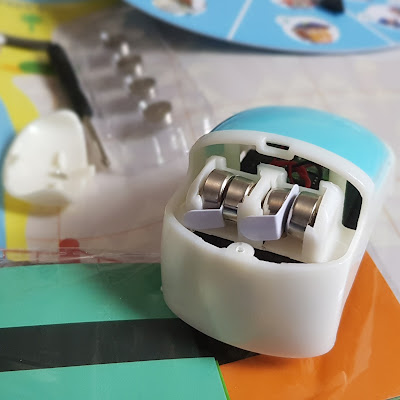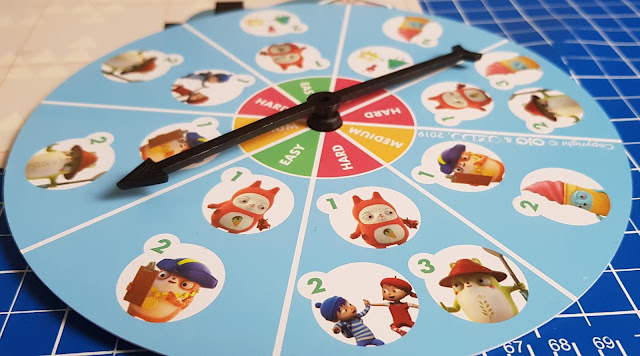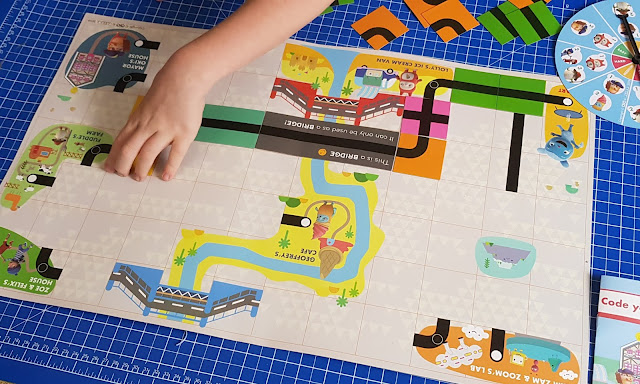Which Way? Coding Board Game is a bit young for my own children, so I enlisted help from some of the children who play in my garden all Summer, but they don't appear in the photos or video.
I'm really impressed right from the start. This is a game which teaches young children to think 'like a coder' and prepares them for genuine computer programming and use. The design is simple genius, a line-following robot car with a magnetic board and track pieces, which are designed to replicate blocks of computer code.
Everything is packaged in a useful, sturdy box with a handle. There is some plastic to protect parts inside during transit, but the disposable packaging is mainly a large piece of card.
The Magnetic Game Board is really quite big and arrives bent in half, but it's heavy and flattens pretty quickly once out of the packaging. A few small pieces of track are drawn on the board to give children an idea of where, and how to start.
There is a short instruction booklet which also has a few simple puzzles and at the back a scoreboard to keep track of your games. It's very easy to understand and the rules are simple, allowing players to concentrate on actual gameplay.
As well as the Magnetic Game Board and booklet there are the Magnetic Tiles, Magic Oki-doodle Car and Mission Wheel, and then very impressively you have a screwdriver and replacement batteries. That's a great touch. The car even has batteries inside already, making this a very Christmas morning-friendly toy. No searching or waiting for batteries or a screwdriver, get it out and play!
Gameplay is really simple. Spin the spinner and see which of the town's residents you have to visit, and in which order. There are 3 levels of difficulty and the residents images are shown, so your child doesn't need to be able to read or know names to follow what they need to do.
The player works out their route using their finger, before attempting to replicate it using the magnetic tiles - or blocks - and put their theory to the test. The basics of coding and scientific experiment.
The little self-driving Oki-doodle car is a line-following robot and tracks the lines really well using sensors underneath. It does get confused sometimes, which prompts your child to troubleshoot and work out why the car isn't following the line. Usually because the joints aren't straight enough!
This is a real hit! It's been amazing watching my own children play with Which Way? There's a real sense of achievement in planning the route and finding it works, and the little car is very cute. It rolls along with a little wiggle and gets confused and sets off on whatever lines it can find.
Although Which Way? is a board game, my children have preferred free play to spin the wheel and make the tracks by themselves for their own pleasure. It's really rewarding to work out the shortest or most intricate tracks possible and then watch the little car bumble along the track.
When you play competitively, obviously you play for points - but as far as we are concerned at least, that's not the most important part of Which Way? Game. Here's a quick unboxing and a look at how it works...
We are really impressed. My boys are above the top end of the suggested age range, but we've all had lots of fun with this set. It's not just a game, it works as a car and track set, and the way it encourages you to think in 'code' blocks is very clever and natural.
The magnetic board works very well and the little self-driving Oki-doodle car is my new favourite robot. In my opinion this is a great introduction to coding, as well as being rewarding and fun.
The OKIDO Which Way? Game costs a mere £30, which is great value in my opinion for something that offers lots of fun and learning alongside. Available now from the OKIDO website (postage is currently £2.22 UK mainland).
We were sent our Which Way? Game for review by OKIDO













This looks like a great game. My little one would love this and anything that gets kids into coding is a big win from me x
ReplyDeleteAwww definitely. It makes it so intuitive, they won't even realise that they've already learned the concept when they start doing it at school - it will be natural to think in 'blocks' :)
Delete